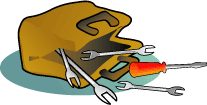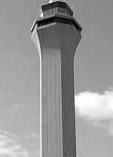An ASRS report that appears in CALLBACK is meant to stimulate thinking about aviation safety. The following reports offer a few thoughts that might prompt us to think twice when that 'little voice' says, "Something's not right."


A
misunderstanding leads to an unexpected reconfiguration, a look of
consternation, an unplanned deceleration, an embarrassing interrogation,
and aresolve to improve communication.
- We
were assigned FL 240 with clearance to cross INTXN at 10,000 feet
and 250 knots. At approximately 78 DME, Center asked if we were
going to be able to get down by INTXN. The
First Officer had started the descent [checklist] and was responding
to an ATC query. I stated (to the First Officer), "We're down,"
as I had already started the descent. The First Officer extended
the landing gear at 23,000 feet and 300+ knots. He thought I said,
"Gear down." We attempted to raise the gear, but were
unsuccessful until we slowed below 250 knots. The First Officer
informed ATC that we were temporarily unable to maintain the assigned
speed of 310 knots. ATC asked if there was a problem...then vectored
us off track and then back to the Arrival. During the vector, the
gear retracted normally and we resumed [our] assigned speed.
From the First Officer's report:
While
I was starting to run the descent checklist, I noticed that we were
a little high for our descent to INTXN Because we were high, ATC
had told us to expedite our descent, and I heard the Captain say,
"Gear down." I quickly lowered the gear handle. After
I had put the handle down I realized that could not have been what
the Captain had asked for— and the look on his face confirmed
it...Upon reflection...I realize that I should not react so fast
to an order that is not a normal procedure. If I had questioned
the order first, then the Captain could have cleared up my misunderstanding.
CRM works if you use it.

A B757 pilot shows that even when we think we are paying attention, the thinking process can be short-circuited by a preconceived notion.
- Approach said, "Expect Runway 18R." On short final I thought I heard, "Cleared to land Runway 18R." I asked [Tower to] confirm clearance to land. Again, I thought he said, "Cleared to land Runway 18R." After landing, Tower said both transmissions were, "Cleared to land Runway 18L." [I] don't know what to say. I just kept thinking Runway 18R.
In another "I thought he said" incident, a Tower controller might have helped the involved pilot avoid a wrong runway landing by mentioning a change of runway assignments in the clearance.
- At ten miles out, I [gave] my position[and] was told to enter a right pattern to Runway 28. I was also told to report the river, which is about three miles out. I reported the river where I was told to continue to Runway 28 and enter a right downwind. When I got abeam Runway 20, I was cleared to land Runway 20. I didn't catch the difference in the two runways. I was told twice to report Runway 28 and when told Runway 20, I thought he said Runway 28. I landed on Runway 28...The controller asked why I landed on Runway 28 instead of Runway 20. I responded that I didn't realize that I had made that mistake.
The pilot in our next report makes three references to "thinking" about where he is going, but doesn't appear to be "hearing" any directions until the First Officer says, "Stop!"
- Tower told us to hold short of Runway 19L. The First Officer acknowledged the call from Tower and confirmed the "Hold short of Runway 19L" [clearance]. I, however, was thinking Runway 19R. We proceeded on Taxiway L toward Runway 19L, but since I was thinking Runway 19R, I crossed the hold short line for Runway 19L. The First Officer rightly called for the "hold short," and I was still thinking (erroneously) to hold short of Runway 19R. The First Officer, recognizing that we weren't actually stopping, said, "Stop!" At that point, I quickly applied the brakes and stopped the aircraft about 20 feet beyond the hold short line. A light aircraft (a C172, I think) on final went around, seeing that we had crossed the hold short line. Tower then cleared us into "position and hold" on Runway 19R. Lessons learned: 1) Confirm with the First Officer the actual taxi/hold short instructions. 2) Check final approach corridor for traffic. 3) Call out simple commands like, "Stop now" that don't require further thought.
With sophisticated aircraft systems, extensive training, comprehensive checklists, and CRM, it is hard to imagine some of the "classic" flying errors happening today. The pilot who submitted this report probably felt the same way, until...
- Departure called an early turn for traffic at approximately 800 feet AGL. This momentary distraction made me forget to call for "Flaps up, VNAV" which is the standard procedure. My First Officer also forgot to back me up.... At 3000 feet MSL, I called for the After Takeoff checklist. The First Officer ran the checklist, but during the "Flaps and Slats Up" challenge, he didn't realize the flaps were still at the takeoff position. After accelerating at 10,000 feet, I felt a buffeting similar to light chop and checked the flap gauge. Airspeed at this point was 270 knots, a 40 knot flap over-speed. After slowing to 225 knots, I called for flaps up, and then proceeded to call company maintenance for further guidance.
In retrospect, it's very hard to believe I allowed this major oversight. I never thought it would happen to me... I discussed with my First Officer my technique in running the after takeoff checklist which is to check the gauge (flaps) and then look up to check the leading edge devices annunciator panel...He was quite confident that he checked the gauge, but feels he must have "looked right through it."

Factors such as weather and fatigue have contributed to many aviation incidents and accidents. In the following ASRS report, a corporate pilot cites several common factors that contributed to a mistake he thought would "never happen to me."
- I
departed from a parallel taxiway instead of the runway. I never
thought I could ever do such a stupid, unsafe maneuver. Leading
factor: fatigue; Second: "That will never happen to me"
attitude; Third: complacency; Fourth: weather; Fifth: I was in a
hurry to get home. We had already been up more than 24 hours even
though, technically, we were legal... After being cleared for takeoff
by the tower, I lined up on a long, wide parallel taxiway and took
off, rushing the poor copilot and myself. I realized my error just
as we lifted off. Tower said nothing. Commuter aircraft were behind
me and must have seen it— in disbelief. Nothing was said. It
was dark and foggy. Tower may not have been able to see either.
Tower and ground may have been the same person that early in the
morning. Maybe he was busy.
This event has cautioned me about two things: 1) fatigue is insidious, and 2) I'm not as good as I thought I was, but I'll get better for sure.


Several
recent ASRS maintenance reports have indicated a recurring oil filler
cap problem. These incidents should be of particular interest to operators
of PW JT-8 engines. Our thanks to the maintenance technicians who
shared their findings and recommendations.
- The
Pratt & Whitney JT-8 engine oil filler cap locking mechanism
can visually appear to be seated in the full down and locked detent
when actually it is not! The handle is too small to effectively
be leveraged to the locked position with thumb and forefinger only,
especially in cold weather. Such was the case, I believe, when I
properly serviced the left and right engine oil, then secured both
engine oil fill caps. Upon departure, the crew noticed a decrease
in right engine oil level and safely diverted to ZZZ where the right
engine oil filler cap was found slightly dislodged. This cap needs
either a redesign or modification to prevent a much more serious
emergency in the future...
An Air
Traffic Controller's report to ASRS shows how pilots' useof vague
terminology can cause concern in an atmosphere of increased security.

- We
recently experienced two incidents in which pilots have used vague
terms when describing conditions affecting their aircraft. In one
case, the pilot was on the ground and
reported [that] he had "issues" before leaving the frequency
for an
extended period
of time while
on a taxiway. In the second
instance, the pilot made
reference to "a situation" while airborne. The pilot wanted
to circle the airport
for an unspecified period of
time, but was not specific regarding why
he needed
to circle. In both cases, the controllers and supervisors-in-charge
had concerns
about the safety of the flight crew and
passengers... Fortunately, neither
case involved unlawful interference. However,
the words used by the pilots
certainly raised suspicions and concerns among ATC personnel...
Pilots
should be aware that vague references might be misinterpreted as
a pilot
attempting to covertly alert ATC to an instance of unlawful interference.
Now, more than ever...communication is key to ensuring that ATC
does not overreact to a minor problem or, even worse, under-react
to a life threatening condition.


![]()
![]()

![]()

![]()
![]()

![]()
